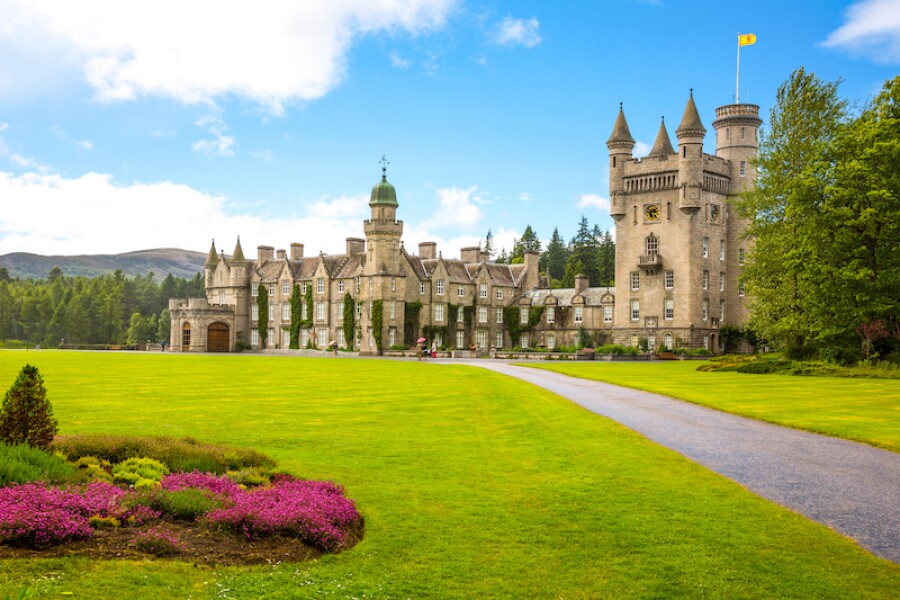It was no secret that the late Queen Elizabeth II—laid to rest today at St. George’s Chapel at Windsor Castle, following a week of public mourning and 70 years as Britain’s longest-reigning monarch—was her happiest a bit farther north.
To the Highlands of Scotland, quite literally the highest part of the United Kingdom, the royal family would decamp every summer for weeks of peace and quiet at Balmoral Castle in Aberdeenshire. It was a tradition dating back to Queen Victoria, who had her eyes on this prize—a windswept, grassy green-and-heathered moorlands—since the 1850s, particularly a lesser castle deemed too small but in just the right spot. Prince Albert bought the estate and gifted it to his wife, who then ordered the castle be torn down. Balmoral Castle as it stands was completed in 1856; it’s now 50,000 acres and 150 buildings, with the nearby town of Braemar, about a 10-minute drive from the estate, expanding in its wake.
“I think Granny is the most happy there,” said Princess Eugenie in the documentary The Queen at Ninety. “I think she really, really loves the Highlands.”
As for a day in the life at Balmoral, Eugenie said it was predominantly “walks, picnics, dogs—a lot of dogs, there’s always dogs—and people coming in and out all the time. … [It was] a lovely base for Granny and Grandpa, for us to come and see them up there, where you just have room to breathe and run.”

Heather in season in Cairngorms National Park near Lecht Ski Resort, Scottish Highlands.
Milosz Maslanka / Shutterstock
Room to breathe and run is right: Even outside the comfy confines of a royal estate, the U.K.’s largest national park, the 1,748-square-mile Cairngorms, is here. (I say “here” because I’m literally writing this story from a desk at the Fife Arms in Braemar.) Travelers make their way to the Cairngorm Mountains to “bag some Munros”—aka climb Scotland’s tallest peaks, a list of 282 cataloged by mountaineer Sir Hugo Munro. But even just getting outside for a walk in these parts is good for the soul, be it through woodlands or along the moors, as Queen Elizabeth was known to do with family and especially her beloved corgis.
It’s ironic that the monarchy found comfort in this part of Scotland: On the drive up from Edinburgh, along an old military road, a decorated stone commemorates the Jacobite rebellion of 1715 outside the entrance to Braemar. (A quick history refresher: The Jacobite rising of 1715 was the failed attempt of James Edward Stuart to reclaim the thrones of England, Ireland, and Scotland for the Catholic Stuart line.) Thankfully, everyone seems to have a great sense of humor up here—a common trait among some of the friendliest people in the world. (It’s true: They’ve been ranked.)
“I have spoken before of my deep and abiding affection for this wonderful country,” the Queen said in a speech to the Scottish Parliament last year. “It is the people that make a place and there are few places where this is truer than Scotland.”
As one local told me today, in Scotland, they don’t look down on anyone, but they also don’t look up. “We are equals,” he said. Perhaps that’s a reason Queen Elizabeth II could just be Lilibet when she was in Aberdeenshire—sleeves rolled up and doing the dishes after Philip finished grilling dinner.
“You think I’m joking, but I’m not,” former Prime Minister Tony Blair once noted in his autobiography, A Journey: My Political Life. “They put the gloves on and stick their hands in the sink. The Queen asks if you’ve finished, she stacks the plates up and goes off to the sink.”

The Palace of Holyroodhouse, bottom left, sits beneath Arthur’s Seat hill in Edinburgh.
Joe Dunckley/Shutterstock
The Queen’s legacy across Scotland
St. Giles Cathedral, Edinburgh: Shortly after her coronation at age 25, Queen Elizabeth II spent a week in Scotland, including a dedication at the Old Town cathedral on June 24, 1953. St. Giles was also one of her final resting places as the coffin made its way from Balmoral to Edinburgh, before continuing to Westminster Abbey and finally Windsor Castle.
Royal Yacht Britannia, Leith: The Britannia launched from Clydebank, Scotland, in 1953, and it served the Royal Family for more than 44 years and a million nautical miles. It was decommissioned in 1997 and is now a major tourist attraction in Leith.
Palace of Holyroodhouse, Edinburgh: The Queen would take meetings (and hold garden parties) at this palace in the shadow of Arthur’s Seat, an ancient volcano and the highest hill in Edinburgh. The relatively new Scottish Parliament, founded in 1999, is right next door.
Glamis Castle, Angus: Queen Elizabeth II’s mother was born Lady Elizabeth Angela Marguerite Bowes Lyon, the youngest daughter of Lord and Lady Glamis, in Angus, north of Dundee. Glamis Castle served as a convalescence hospital during World War I, where Lady Elizabeth helped wounded soldiers. Princess Margaret was born here, and she and Elizabeth II spent happy days picnicking and horseback riding at Glamis Castle.











